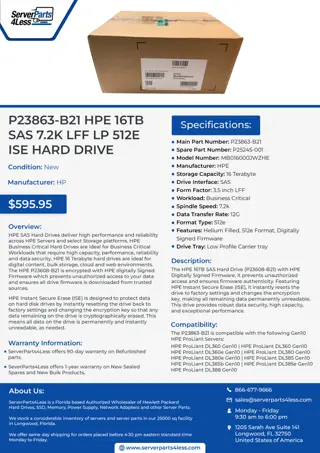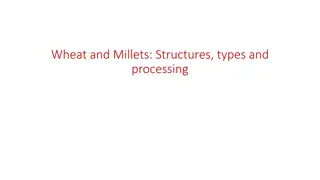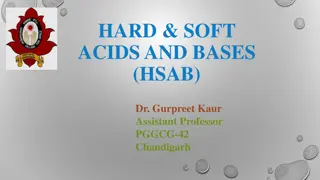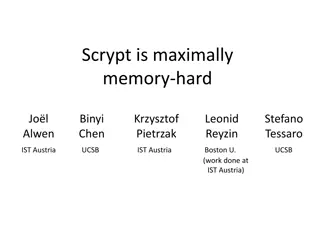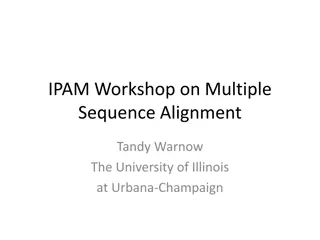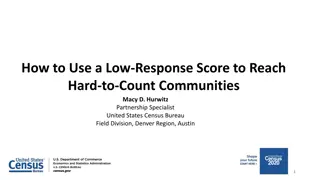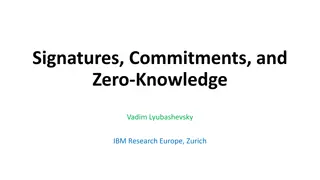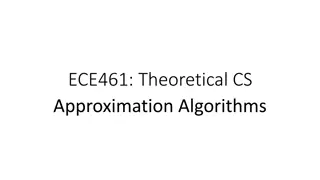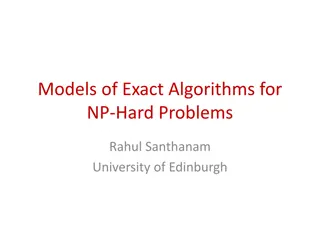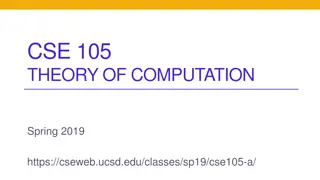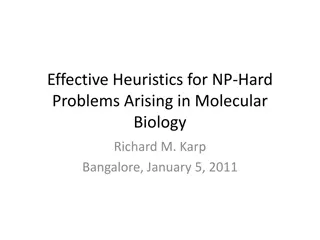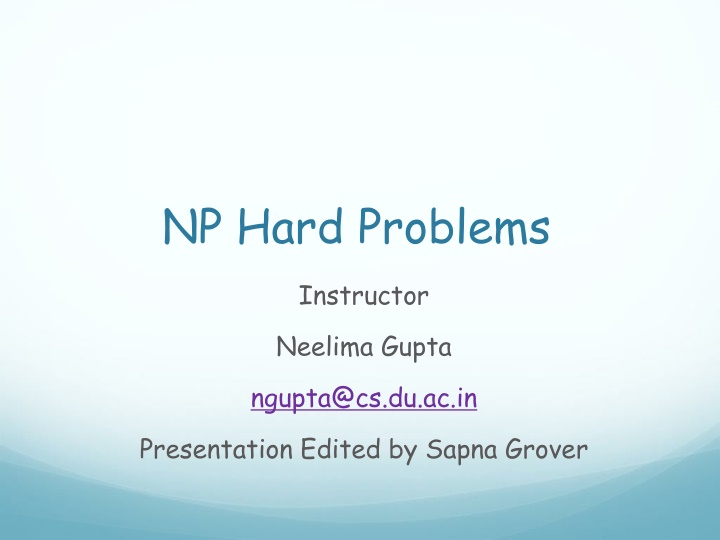
NP Hard Problems
This presentation explores the concept of NP-Hard problems, focusing on NP-Hardness reductions, transformation characteristics, and the relationship between different problem instances. It delves into the intricacies of problem reducibility and provides examples to illustrate key concepts in computational complexity theory. The content emphasizes the importance of understanding the complexity classes and how problems can be interrelated through reductions.
Download Presentation

Please find below an Image/Link to download the presentation.
The content on the website is provided AS IS for your information and personal use only. It may not be sold, licensed, or shared on other websites without obtaining consent from the author. If you encounter any issues during the download, it is possible that the publisher has removed the file from their server.
You are allowed to download the files provided on this website for personal or commercial use, subject to the condition that they are used lawfully. All files are the property of their respective owners.
The content on the website is provided AS IS for your information and personal use only. It may not be sold, licensed, or shared on other websites without obtaining consent from the author.
E N D
Presentation Transcript
NP Hard Problems Instructor Neelima Gupta ngupta@cs.du.ac.in Presentation Edited by Sapna Grover
Table of Contents NP Hardness Reductions
NP - Hard The aim to study this class is not to solve a problem but to see how hard the problem is?
Reduction The crux of NP-Hardness is reducibility We say that a problem P is reduced to another problem Q if an instance of P can be easily transformed into an instance of Q, the solution to which provides a solution to the instance of P. Intuitively it means that if one can solve Q then one can solve P also, i.e. P is no harder to solve than Q or Q is at least as hard as P.
Poly. Time IQ IP IP : Instance of problem P IQ : Instance of problem Q Poly. Time SP : Solution of problem P SP (Yes/ No) SQ (Yes/ No) SQ : Solution of problem Q
Transformation Characterstics If A(Q) is yes then A(P) is yes Vice versa It should be done in polynomial time
Reducibility An example: P: Given a set of Booleans, is at least one TRUE? Q: Given a set of integers, is their sum positive? Transformation: (x1, x2, , xn) = (y1, y2, , yn) where yi = 1 if xi = TRUE, yi = 0 if xi = FALSE Another example: Solving linear equations is reducible to solving quadratic equations How can we easily use a quadratic-equation solver to solve linear equations?
NP hard Q is s.t.b. NP-hard if P NP, P p Q Poly. Time IQ IP IP : Instance of problem P IQ : Instance of problem Q Poly. Time SP : Solution of problem P SP (Yes/ No) SQ (Yes/ No) SQ : Solution of problem Q
If all problems R NP are reducible to T, then T is NP-Hard T is NP hard
If T is NP-Hard And T NP then T is NPC. T NPC Q NP If T p Q then Q is NP hard.
Diagrammatically NP HARD NPC
The SAT Problem One of the first problems proved to be NP-Hard was satisfiability (SAT): Given a Boolean expression on n variables, can we assign values such that the expression is TRUE? Ex: ((x1 x2) (( x1 x3) x4)) x2 Cook s Theorem: The satisfiability problem is NP-Hard (actually NP Complete will do this later) Note: Argue from first principles, not reduction Proof: not here
Conjunctive Normal Form Even if the form of the Boolean expression is simplified, the problem is NP-Hard (NP Complete) Literal: an occurrence of a Boolean or its negation A Boolean formula is in conjunctive normal form, or CNF, if it is an AND of clauses, each of which is an OR of literals Ex: (x1 x2) ( x1 x3 x4) ( x5) 3-CNF: each clause has exactly 3 distinct literals Ex: (x1 x2 x3) ( x1 x3 x4) ( x5 x3 x4) Notice: true if at least one literal in each clause is true
The 3-CNF Problem Thm 36.10: Satisfiability of Boolean formulas in 3-CNF form (the 3-CNF Problem) is NP-Hard (NP-Complete) Proof: Nope The reason we care about the 3-CNF problem is that it is relatively easy to reduce to others Thus by proving 3-CNF NP-Hard we can prove many seemingly NP-Hard unrelated problems
CLIQUE is NP Hard Pick up a problem known to be NPHard and Transform (reduce) the known problem to CLIQUE 0 Give the transformation 1. Show that under the transformation : solution of known problem is yes => solution to CLIQUE is yes. 2. Show that under the transformation : solution of CLIQUE is yes => solution of the known problem is yes. 3. Show that the transformation can be done in time polynomial in the length of an instance of the known problem. SO, THREE STEPS TO REDUCE A KNOWN PROBLEM TO CLIQUE.
3-CNF Clique What should the reduction do? A: Transform a 3-CNF formula to a graph, for which a k-clique will exist (for some k) iff the 3- CNF formula is satisfiable.
3-CNF Clique The reduction: Let B = C1 C2 Ck be a 3-CNF formula with k clauses, each of which has 3 distinct literals For each clause put a triple of vertices in the graph, one for each literal Put an edge between two vertices if they are in different triples and their literals are consistent, meaning not each other s negation
Let the expression in 3CNF be: (~x v y v z) ^ (x v ~y v ~z) ^ (x v y v z) Expression Graph ~x y z x x y ~y ~z z
Clique thus formed: y y x x z z Note:- There are many other possible cliques in previous mapping. This is one of the possible cliques.
3-CNF Clique Prove the reduction works: If B has a satisfying assignment, then each clause has at least one literal (vertex) that evaluates to 1 Picking one such true literal from each clause gives a set V of k vertices. V is a clique (Why?) If G has a clique V of size k, it must contain one vertex in each triple (clause) (Why?) We can assign 1 to each literal corresponding with a vertex in V , without fear of contradiction
Reduction takes polynomial time Let there be n variables in the 3-CNF with k clauses Then, the input size is theta(k + n). Size of the graph = 3k*3(k-1)
Vertex Cover is NP-Hard Pick up a problem known in NP-hard CLIQUE
Clique p Vertex Cover Let the instance of Clique ( Ic) be <G, k>. Reducing it to instance of VC (Ivc) be <G , |V|-k> where G : E(G )=Edges b/w vertex pair not present in G and |V|-k is the vertex cover. Catch behind this choice : Because it works !!!
G Green ovals represent CLIQUE for this graph
G G Big ovals represent the VC for graph G
Clique Vertex Cover Reduce k-clique to vertex cover The complement GC of a graph G contains exactly those edges not in G Compute GC in polynomial time G has a clique of size k iff GC has a vertex cover of size |V| - k
Clique Vertex Cover Claim: If G has a clique of size k, GC has a vertex cover of size |V| - k Let V be the k-clique Then V - V is a vertex cover in GC Let (u,v) be any edge in GC Then u and v cannot both be in V (Why?) Thus at least one of u or v is in V-V (why?), so edge (u, v) is covered by V-V Since true for any edge in GC, V-V is a vertex cover
Clique Vertex Cover Claim: If GC has a vertex cover V V, with |V | = |V| - k, then G has a clique of size k For all u,v V, if (u,v) GC then u V or v V or both (Why?) Contrapositive: if u V and v V , then (u,v) E In other words, all vertices in V-V are connected by an edge, thus V-V is a clique Since |V| - |V | = k, the size of the clique is k
Independent Set Problem Independent Set : A subset S of V is said to be independent if no 2 nodes in S are joined by an edge. Problem Statement: Given a graph G=(V,E), find an independent set that is as large as possible.
Exercise Show that Independent Set is NP Hard by reducing it from 3 CNF Clique Vertex Cover Show that Vertex Cover is NP Hard by reducing it from 3 CNF
Subset Sum Problem Problem Statement Given: A finite set S of natural numbers. A target t N. To Find: If there exists a subset S of S whose elements sum up to t.
Subset Sum Problem We now prove that Subset Sum Problem is NP-Complete. Subset Sum is in NP. For an instance <S,t>, let S be the certificate. Checking whether elements of S sum to t can be done in polynomial time.
Subset Sum Problem Subset Sum is NP Hard We show this by proving that 3-SAT is reducible to Subset Sum in polynomial time. Given: 3-SAT formula over variables x1, x2, xn with clauses C1, C2 Ck
Subset Sum Problem Without loss of generality, we make the following 2 assumptions: No clause contains both a variable and its negation. WHY? (Because such a clause would be trivially satisfied.) Each variable appears in at least 1 clause. WHY? (Because otherwise, it does not matter what value is assigned to it.)
Subset Sum Problem Reduction Process - through example Consider the 3-SAT formula : = C1^ C2 ^ C3 ^ C4 where C2 =(x1 v x2 v x3 ) C3 =(x1 v x2 v x3) C4 =(x1 v x2 v x3) A satisfying assignment is <x1=0, x2=0, x3=1> C1 =(x1 v x2 v x3 )
Subset Sum Problem Steps: Create 2 numbers in set S for each variable xi and 2 numbers for each clause Cj. These numbers are in base 10 and each has n+k digits. Each digit corresponds to a variable or a clause. Label least significant k digits by clauses and most significant n digits by variables.
Subset Sum Problem Do the following for i = 1 n If xi = 1 in the assignment, include vi in S , otherwise include vi . In the example, x1=0 => x1 =1 , v1 is selected x2=0 => x2 =1 , v2 is selected x3=1 => x3=1 , v3 is selected
(x1 v x2 v x3 ) (x1 v x2 v x3 ) (x1 v x2 v x3) (x1 v x2 v x3) Satisfying assignment x1=0, x2=0, x3=1 x1 , x2 and x3 are selected. X1 X2 X3 C1 C2 C3 C4 V1 1 0 0 1 0 0 1 V1' 1 0 0 0 1 1 0 V2 0 1 0 0 0 0 1 V2' 0 1 0 1 1 1 0 V3 0 0 1 0 0 1 1 V3' 0 0 1 1 1 0 0 S1 0 0 0 1 0 0 0 S1' 0 0 0 2 0 0 0 S2 0 0 0 0 1 0 0 S2' 0 0 0 0 2 0 0 S3 0 0 0 0 0 1 0 S3' 0 0 0 0 0 2 0 S4 0 0 0 0 0 0 1 S4' 0 0 0 0 0 0 2 t 1 1 1 4 4 4 4
(x1 v x2 v x3 ) (x1 v x2 v x3 ) (x1 v x2 v x3) (x1 v x2 v x3) Satisfying assignment x1=0, x2=0, x3=1 X1 X2 X3 C1 C2 C3 C4 V1 1 0 0 1 0 0 1 V1' 1 0 0 0 1 1 0 V2 0 1 0 0 0 0 1 V2' 0 1 0 1 1 1 0 V3 0 0 1 0 0 1 1 V3' 0 0 1 1 1 0 0 S1 0 0 0 1 0 0 0 S1' 0 0 0 2 0 0 0 S2 0 0 0 0 1 0 0 S2' 0 0 0 0 2 0 0 S3 0 0 0 0 0 1 0 S3' 0 0 0 0 0 2 0 S4 0 0 0 0 0 0 1 S4' 0 0 0 0 0 0 2 4 0 t 1 1 1 4 4 4 4
(x1 v x2 v x3 ) (x1 v x2 v x3 ) (x1 v x2 v x3) (x1 v x2 v x3) Satisfying assignment x1=0, x2=0, x3=1 X1 X2 X3 C1 C2 C3 C4 V1 1 0 0 1 0 0 1 V1' 1 0 0 0 1 1 0 V2 0 1 0 0 0 0 1 V2' 0 1 0 1 1 1 0 V3 0 0 1 0 0 1 1 V3' 0 0 1 1 1 0 0 S1 0 0 0 1 0 0 0 S1' 0 0 0 2 0 0 0 S2 0 0 0 0 1 0 0 S2' 0 0 0 0 2 0 0 S3 0 0 0 0 0 1 0 S3' 0 0 0 0 0 2 0 S4 0 0 0 0 0 0 1 S4' 0 0 0 0 0 0 2 4 1 t 1 1 1 4 4 4 4
(x1 v x2 v x3 ) (x1 v x2 v x3 ) (x1 v x2 v x3) (x1 v x2 v x3) Satisfying assignment x1=0, x2=0, x3=1 X3 X2 X1 C1 C2 C3 C4 V1 1 0 0 1 0 0 1 V1' 1 0 0 0 1 1 0 V2 0 1 0 0 0 0 1 V2' 0 1 0 1 1 1 0 V3 0 0 1 0 0 1 1 V3' 0 0 1 1 1 0 0 S1 0 0 0 1 0 0 0 S1' 0 0 0 2 0 0 0 S2 0 0 0 0 1 0 0 S2' 0 0 0 0 2 0 0 S3 0 0 0 0 0 1 0 S3' 0 0 0 0 0 2 0 S4 0 0 0 0 0 0 1 S4' 0 0 0 0 0 0 2 4 2 t 1 1 1 4 4 4 4
(x1 v x2 v x3 ) (x1 v x2 v x3 ) (x1 v x2 v x3) (x1 v x2 v x3) Satisfying assignment x1=0, x2=0, x3=1 X3 X2 X1 C1 C2 C3 C4 V1 1 0 0 1 0 0 1 V1' 1 0 0 0 1 1 0 V2 0 1 0 0 0 0 1 V2' 0 1 0 1 1 1 0 V3 0 0 1 0 0 1 1 V3' 0 0 1 1 1 0 0 S1 0 0 0 1 0 0 0 S1' 0 0 0 2 0 0 0 S2 0 0 0 0 1 0 0 S2' 0 0 0 0 2 0 0 S3 0 0 0 0 0 1 0 S3' 0 0 0 0 0 2 0 S4 0 0 0 0 0 0 1 S4' 0 0 0 0 0 0 2 4 3 t 1 1 1 4 4 4 4
Subset Sum Problem Construct S and t as follows: t has a 1 in each digit labeled by a variable and 4 in each clause-digit. For each xi, there exist 2 integers vi, vi in S. Both vi and vi have 1 corresponding to digit xi. If xi appears in Cj, the Cj-digit in vi = 1 If vi appears in Cj, the Cj-digit in vi = 1 All other digits are zero.
Subset Sum Problem Claim: All vi and vi in S are unique vi (vi ) and vj (vj ) will be different in most significant positions. vi and vi will be different in least significant positions. WHY? (both cannot belong to the same clause)
Subset Sum Problem For all Cj, there exist sj and sj integers in S. Both have 0 s in all digits other than the one labeled by Cj. sj has a 1 corresponding to Cj, and sj has a 2 corresponding to Cj. These integers are slack variables, used to get clause labeled digit position to add to the target value of 4.
Subset Sum Problem Claim: All sj and sj in S are unique (for reasons similar to vi and vi ) Observation: The greatest sum of digits in any digit position is 6. This occurs in clause-digits (vi and vi make a contribution of 3, sj and sj make a contribution of 1 and 2 respectively). Conclusion: Interpretation is in base 10, so no carries would be generated. REDUCTION DONE !!
Subset Sum Problem Claim: This reduction can be done in polynomial time. S contains 2n+2k values. Each has n+k digits. Each digit takes time polynomial in (n+k) to be produced. t has n+k digits each being produced in constant time. Hence Proved !
Subset Sum Problem To Prove: 3-SAT is satisfiable if and only if there exists a subset S of S whose elements sum to t . Proof Part 1 Given: has a satisfying assignment.
Subset Sum Problem Do the following for i = 1 n If xi = 1 in the assignment, include vi in S , otherwise include vi . In the example, v1 , v2 , v3 belong to S . Note: For each variable digit, the sum of values of S must be 1 ( = those of target t)






